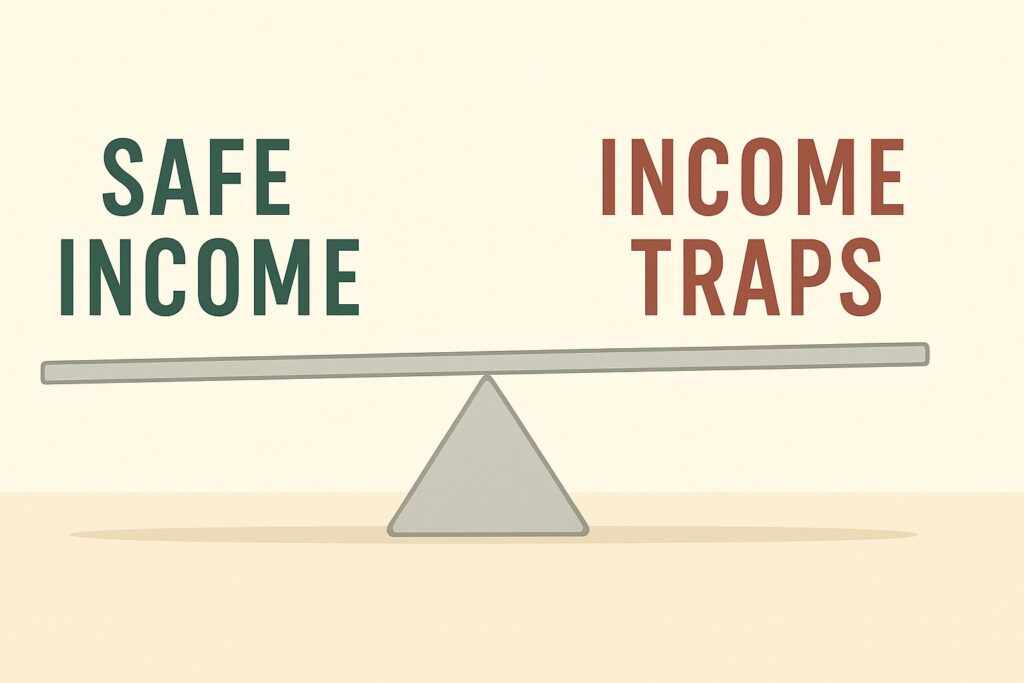
How to separate income opportunities from income traps in your retirement portfolio
If you’re in retirement—or heading there soon—it’s natural to look for investments that offer high yields. After all, what could be better than earning 7%, 8%, or even 10% annual income without touching your principal?
But here’s the truth: not all high yields are created equal.
Some offer real, sustainable income. Others are income traps that can quietly erode your portfolio with hidden risks, declining asset values, or sudden dividend cuts.
This post will help you tell the difference, so you can confidently earn more income without putting your retirement at unnecessary risk.
✅ Why High Yields Are So Tempting—And So Dangerous
Let’s face it—when safe bonds are yielding 4–5%, it’s easy to be lured by a stock or fund offering 9% or more. But if a yield looks too good to be true, it might be masking real problems.
Some of the most common high-yield traps include:
- Unsustainable payout ratios (paying more in dividends than they earn)
- Declining business models
- Over-leveraged balance sheets
- High sensitivity to interest rates
- Complicated structures, like MLPs or exotic closed-end funds
Chasing yield without understanding the risks can leave retirees with dividend cuts, falling share prices, or both.
✅ How to Spot a Safe High-Yield Opportunity
Here’s a simple checklist to help you evaluate whether a high yield is worth the risk:
1. Is the dividend covered by cash flow or earnings?
Look for a payout ratio below 80% for most companies (REITs and MLPs can go higher, but should still have excess cash coverage).
2. Is the business model stable and recession-resistant?
Favor companies that provide essential services—like utilities, pipelines, or real estate serving healthcare or logistics sectors.
3. How much debt is on the books?
Too much leverage can turn a good yield into a ticking time bomb. Compare debt-to-equity and interest coverage ratios.
4. Has the company (or fund) maintained or grown its dividend through past recessions?
History matters. Look for proven management that prioritizes steady income.
5. Is the yield consistent with peers—or way higher?
If everyone else in the sector yields 6%, but one stock yields 12%, that’s a red flag.
✅ Real-Life Example: The Difference Between XFLT and a Dividend Trap
Tom, a retired school principal, was tempted by a stock offering a 13% yield. But after digging deeper, he realized the company had declining revenues and was funding dividends with borrowed money. He passed.
Instead, he chose XFLT, a well-managed closed-end fund that holds floating-rate senior loans. It yields around 10% and:
- Has a strong record of maintaining payouts
- Benefits from rising interest rates
- Focuses on senior secured debt (lower risk in the credit stack)
Tom now collects monthly income, sleeps well at night, and doesn’t worry about chasing the next “too good to be true” opportunity.
✅ Don’t Just Chase Yield—Balance It With Safety
There’s nothing wrong with seeking higher income in retirement. In fact, it’s smart to make your money work for you. But the key is to balance yield with sustainability.
Safe high-yield investments do exist—in asset classes like:
- REITs (Real Estate Investment Trusts)
- BDCs (Business Development Companies)
- Preferred stocks
- Closed-end funds (like XFLT, UTG, or PCI)
- Pipeline MLPs
With a little screening and diversification, you can build a retirement portfolio that pays you well without blowing up when the economy stumbles.
📘 This post is adapted from my book:
9% Retirement Paycheck: How to Generate Steady, Worry-Free Income for Life,
Available now on Amazon.com in paperback and eBook formats.
Inside, you’ll discover proven strategies and safe, high-yield investments that can fund your retirement for decades—without relying on risky stock picks or low-yield bonds.
⚠️ Disclaimer
This content is for informational and educational purposes only. It is not intended as financial, investment, or tax advice. Investing involves risk, including the possible loss of principal. Always consult a licensed financial advisor before making any investment decisions. The author is not a registered investment professional and does not provide personalized financial advice.